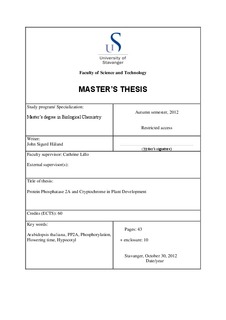| dc.description.abstract | Protein phosphatase 2A (PP2A) is a serine/threonine-specific phosphatase that regulates diverse signaling events in plants. PP2A consist of three subunits, a catalytic subunit (C), a scaffolding subunit (A), and a regulatory subunit (B). The catalytic subunit C occurs in association with the scaffolding subunit A to make the core enzyme. The A subunit works as a scaffold and is essential for recruiting the regulatory subunit B to form the ABC trimer. Previous studies have shown that a PP2A mutant behaves like a CRY (Cryptochrome) overexpressor/strong signaling mutant with respect to blue light and hypocotyl length. This led to the hypothesis that B´α is part of a PP2A complex that dephosphorylates CRY1. Increased phosphorylation of CRY1 will in theory result in more efficient or longer lasting repression of COP1 (Constitutively photomorphogenic 1), which again gives higher levels of CO (Constans). CO directly binds to and activates FT (Flowering locus T) which is an activator of flowering.
Hypocotyl length of B´α mutants was compared to WT (Wild type) by sowing seeds in ½ MS (Murashige-Skoog) media and exposing them to blue light. Shorter hypocotyls of the B´α mutant in blue light were confirmed in 8 out of 9 experiments.
The flowering phenotype of B´α mutants were investigated by comparing them to WT in 8 h, 12 h, and 16 h day lengths. The flowering experiments with the B´α mutants revealed a “weak” phenotype of early flowering in both short and long days. Though the B´α mutants showed earlier flowering in all experiments, statistical significance was only observed in 12 h and 16 h light when compared to WT.
The possible protein-protein interaction between B´α and CRY1 were analyzed by bimolecular fluorescence complementation (BiFC) assay. B´α and CRY1 were tagged with N- or C-terminal fragments of the fluorescent protein Venus and transiently expressed in Arabidopsis mesophyll protoplasts. Fluorescent signals were observed both in combinations of CRY1/ B´α and “empty” vectors, and thereby questioning the specificity of the BiFC assay. However fluorescent signals showing dots/speckles were observed in the combination of CRY1/ B´α and not in control experiments, which indicates protein-protein interaction between CRY1 and B´α.
The flowering and hypocotyl experiments indicate that B´α is involved in the dephosphorylation of CRY1, hence strengthening the working hypothesis. However, more experiments should be done in the future before any firm conclusions are drawn. | no_NO |
